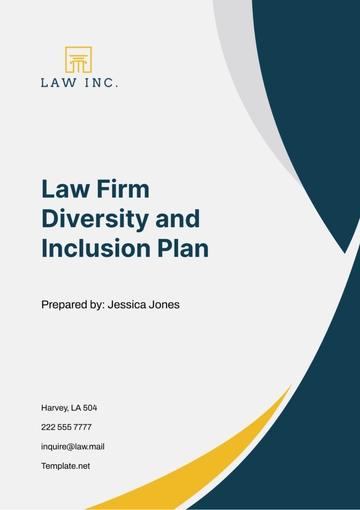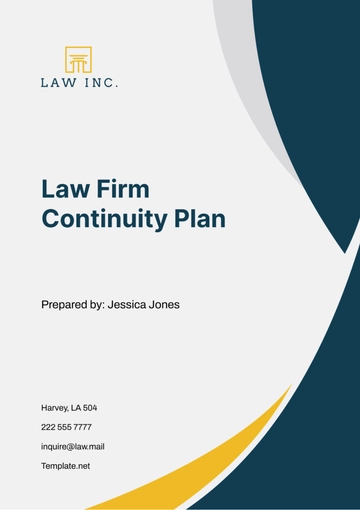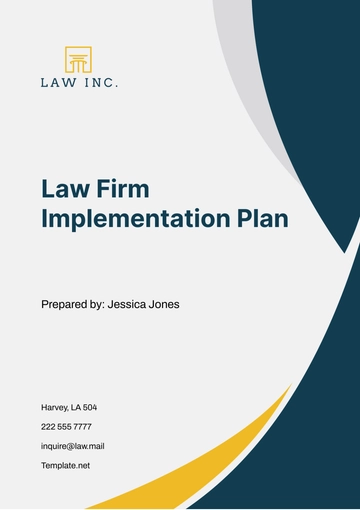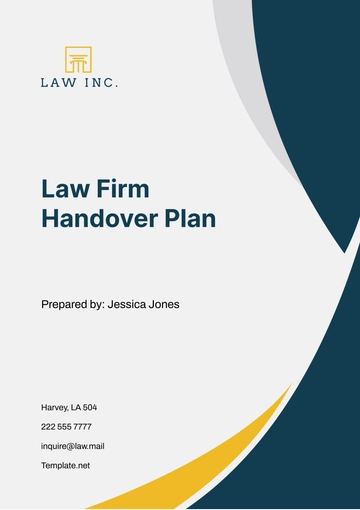Free Law Firm Strategy Plan

I. Executive Summary
A. Overview
[Your Company Name] is a renowned law firm with a distinguished reputation for delivering exceptional legal services tailored to meet the diverse needs of our clients. With over [number of years] years of experience, we have solidified our position as trusted advisors in the legal industry.
This comprehensive strategy plan delineates our strategic objectives and key initiatives aimed at navigating the evolving legal landscape, seizing emerging opportunities, and consolidating our position as a leading law firm.
Through a strategic blend of client-centric approaches, technological innovation, and talent development initiatives, we endeavor to elevate client satisfaction, drive operational efficiency, and sustain long-term growth and profitability.
B. Vision Statement
[Your Company Name] envisions itself as the preeminent destination for legal excellence, recognized for our unwavering commitment to integrity, innovation, and client satisfaction.
C. Mission Statement
Our mission is to provide unparalleled legal representation, deliver innovative solutions, and foster enduring relationships with our clients, employees, and communities. We are guided by the highest standards of professionalism and ethics in all our endeavors.
II. Current State Analysis
A. Market Analysis
The legal industry is undergoing rapid transformation driven by technological advancements, globalization, and evolving client expectations. These trends are reshaping competitive dynamics, service delivery models, and the regulatory landscape.
Key market trends include:
Trends | Impact |
|---|---|
Technological Advances | Transforming legal research, document management, and client communication processes. |
Changing Client Needs | Demand for personalized, value-added legal solutions tailored to specific industries and circumstances. |
Increasing Competition | Proliferation of boutique firms, alternative legal service providers, and global players challenging traditional law firms for market share. |
Client demographics are evolving, with a growing emphasis on diversity, inclusion, and sustainability. Clients seek legal partners who understand their unique challenges, industry nuances, and business objectives.
B. Firm Assessment
[Your Company Name] possesses a rich heritage, comprising a team of experienced attorneys and a diverse client portfolio spanning [number of countries] countries and industries, including [industry1], [industry2], and [industry3].
While the firm enjoys a strong reputation for legal expertise and client service, internal challenges such as legacy systems, inefficient processes, and talent retention issues pose obstacles to maximizing our potential and staying ahead of the competition.
III. Strategic Objectives
A. Client-Centric Approach
Enhance client engagement and satisfaction through personalized service offerings, proactive communication, and responsiveness to client needs. This includes:
Implementing a client feedback mechanism to gather insights and improve service delivery.
Offering tailored legal solutions that align with clients' specific objectives and challenges.
Establishing dedicated client relationship managers to ensure proactive communication and address any concerns promptly.
Develop industry-specific expertise to provide tailored legal solutions addressing clients' evolving challenges and opportunities. This involves:
Investing in ongoing training and development programs to keep abreast of industry trends and regulations.
Creating specialized practice groups focused on key industries or sectors to deepen expertise and offer targeted solutions.
Collaborating with industry associations and thought leaders to stay ahead of emerging trends and anticipate client needs.
Implement client relationship management tools and technology solutions to deepen client relationships, anticipate needs, and deliver value-added services. Key initiatives include:
Adopting CRM software to centralize client data, track interactions, and personalize communication.
Utilizing data analytics to gain insights into client preferences, behavior patterns, and satisfaction levels.
Offering online portals or platforms for clients to access documents, track case progress, and communicate with their legal team.
B. Technological Integration
Invest in advanced legal technology solutions, including artificial intelligence, machine learning, and data analytics, to streamline legal research, automate routine tasks, and improve decision-making processes. This includes:
Deploying AI-powered legal research tools to expedite case preparation, identify relevant precedents, and enhance legal analysis.
Implementing contract management software to streamline document review, negotiation, and compliance processes.
Utilizing predictive analytics to forecast legal outcomes, mitigate risks, and optimize resource allocation.
Leverage cloud computing platforms for secure data storage, collaboration, and remote access, enhancing agility, scalability, and operational efficiency. Key initiatives include:
Migrating to cloud-based document management systems to facilitate seamless access to case files, contracts, and legal documents from anywhere, anytime.
Enhancing cybersecurity measures to protect sensitive client data and comply with regulatory requirements.
Leveraging cloud-based collaboration tools to facilitate real-time communication and collaboration among legal teams and clients.
Provide ongoing training and support to equip staff with digital skills and promote a culture of innovation and technology adoption. This involves:
Offering training programs on the use of legal tech tools, best practices for data security, and compliance with privacy regulations.
Encouraging participation in technology-focused workshops, webinars, and conferences to stay abreast of industry developments.
Establishing a digital innovation hub or center of excellence to foster experimentation, knowledge sharing, and collaboration on technology initiatives.
C. Talent Development
Attract and retain top legal talent by offering competitive compensation packages, professional development opportunities, and a supportive work environment. This includes:
Conducting regular salary benchmarking studies to ensure our compensation packages remain competitive in the market.
Providing opportunities for professional growth through mentorship programs, leadership development initiatives, and access to continuing legal education resources.
Fostering a culture of work-life balance, wellness, and inclusivity to support employee well-being and job satisfaction.
Foster a culture of diversity, equity, and inclusion to harness the full potential of our workforce and drive innovation and creativity. Key initiatives include:
Implementing diversity and inclusion training programs for all employees to promote awareness, empathy, and cultural competence.
Establishing affinity groups or employee resource networks to provide support, networking opportunities, and advocacy for underrepresented groups.
Partnering with diversity-focused organizations, bar associations, and law schools to recruit diverse talent and expand our talent pipeline.
Implement mentorship programs, knowledge-sharing initiatives, and performance recognition systems to nurture talent, promote continuous learning, and facilitate career advancement. This involves:
Pairing junior associates with seasoned mentors to provide guidance, feedback, and career development support.
Creating knowledge-sharing platforms or communities of practice to facilitate the exchange of best practices, insights, and lessons learned.
Recognizing and rewarding outstanding performance, innovation, and contributions to the firm's success through performance bonuses, awards, and public recognition.
IV. Key Initiatives A. Service Expansion
Establish specialized practice groups in emerging areas such as [practice area1] and [practice area2] to capitalize on market opportunities and meet evolving client demands. This includes:
Recruiting attorneys with expertise in niche practice areas or emerging industries to lead new practice groups.
Investing in marketing and business development efforts to raise awareness of our capabilities and attract clients in target sectors.
Offering thought leadership content, webinars, and industry insights to position ourselves as subject matter experts in these areas.
Strengthen international capabilities through strategic partnerships, alliances, and targeted business development initiatives to serve clients with cross-border interests effectively. Key initiatives include:
Establishing alliances with reputable law firms in key international markets to expand our global reach and provide seamless service to clients operating internationally.
Participating in international legal networks, conferences, and trade missions to build relationships, share knowledge, and identify cross-border opportunities.
Offering cross-border legal services, including advice on international transactions, regulatory compliance, and dispute resolution, to support clients' global operations.
B. Process Optimization
Conduct comprehensive process reviews and reengineering efforts to streamline workflows, eliminate redundancies, and enhance operational efficiency across all practice areas. This includes:
Engaging process improvement experts or consultants to conduct workflow analyses, identify bottlenecks, and recommend optimization strategies.
Implementing workflow automation tools and software solutions to standardize processes, reduce manual intervention, and minimize errors.
Establishing performance metrics and key performance indicators (KPIs) to monitor process efficiency, track progress, and drive continuous improvement.
Adopt agile project management methodologies and lean principles to drive continuous improvement, foster collaboration, and deliver projects on time and within budget. Key initiatives include:
Training legal teams on agile methodologies, scrum practices, and Kanban boards to enhance project visibility, alignment, and adaptability.
Conducting regular project retrospectives to reflect on lessons learned, identify areas for improvement, and adjust project plans as needed.
Encouraging cross-functional collaboration and knowledge sharing through agile ceremonies, such as daily stand-ups, sprint reviews, and backlog grooming sessions.
C. Brand Building
Develop and implement a cohesive marketing strategy encompassing digital channels, thought leadership initiatives, and client-centric events to enhance brand visibility and attract prospective clients. This includes:
Refreshing our brand identity, website, and marketing collateral to reflect our values, expertise, and unique value proposition.
Creating thought leadership content, including articles, whitepapers, and blog posts, on topics of interest to our target audience.
Hosting client seminars, webinars, and networking events to foster engagement, showcase our expertise, and build relationships with clients and prospects.
Enhance the firm's online presence through search engine optimization (SEO), content marketing, and social media engagement to engage with target audiences effectively. Key initiatives include:
Optimizing our website for relevant keywords, user experience, and mobile responsiveness to improve search engine rankings and drive organic traffic.
Publishing high-quality content on our website and blog, including legal insights, case studies, and client testimonials, to position ourselves as thought leaders in the industry.
Leveraging social media platforms, such as LinkedIn, Twitter, and Facebook, to share content, engage with followers, and amplify our brand message.
V. Implementation Plan
A. Timeline
Develop a detailed timeline outlining the rollout of key initiatives, milestones, and responsible parties to ensure timely execution and accountability. This includes:
Initiative | Timeline | Responsible Party(s) |
|---|---|---|
Implement CRM Software | Q2 [Year] - Q3 [Year] | IT Department, Marketing |
Conduct Training Programs | Q2 [Year] - Ongoing | HR Department |
Launch Specialized Practice Groups | Q3 [Year] - Ongoing | Practice Group Leaders |
Enhance Website | Q3 [Year] - Q4 [Year] | Marketing, IT |
Establish Strategic Partnerships | Q4 [Year] - Ongoing | Business Development |
Regular progress reviews and performance evaluations will be conducted to monitor the implementation progress and make necessary adjustments.
B. Resource Allocation
Allocate financial resources, technology investments, and human capital in alignment with strategic priorities and anticipated outcomes. This includes:
Resource | Allocation |
|---|---|
Budget | [$5,000,000] |
Technology | [$8,000,000] |
Personnel | [500] |
Establish cross-functional teams and task forces to oversee specific initiatives, promote collaboration, and facilitate knowledge sharing.
VI. Monitoring and Evaluation
A. Performance Metrics
Define key performance indicators (KPIs) such as client satisfaction scores, revenue growth, market share, and employee retention rates to gauge the effectiveness of the strategy. This includes:
KPI | Measurement Method |
|---|---|
Client Satisfaction Scores | Surveys, Feedback Forms |
Revenue Growth | Financial Reports |
Market Share | Market Research, Analysis |
Employee Retention Rates | HR Reports, Exit Interviews |
Implement a robust reporting framework to track KPIs, analyze trends, and identify areas for improvement.
B. Feedback Mechanisms
Solicit feedback from clients, employees, and stakeholders through surveys, focus groups, and regular communication channels to assess the impact of strategic initiatives. This includes:
Stakeholder | Feedback Mechanism |
|---|---|
Clients | Surveys, Feedback Forms |
Employees | Employee Surveys, Forums |
Stakeholders | Focus Groups, Meetings |
Incorporate feedback into decision-making processes and adapt strategies accordingly to address evolving needs and preferences.
VII. Conclusion
[Your Company Name] is committed to implementing this strategic plan to achieve our long-term objectives, strengthen our competitive position, and deliver superior value to our clients. By embracing innovation, fostering talent development, and maintaining a client-centric focus, we are poised to navigate challenges and capitalize on opportunities in the dynamic legal landscape.
We look forward to the continued success and growth of [Your Company Name] as a trusted partner in legal excellence.
- 100% Customizable, free editor
- Access 1 Million+ Templates, photo’s & graphics
- Download or share as a template
- Click and replace photos, graphics, text, backgrounds
- Resize, crop, AI write & more
- Access advanced editor
Develop a comprehensive strategy for your firm with Template.net's Law Firm Strategy Plan Template. This editable and customizable document provides a structured framework for defining objectives, outlining strategies, and allocating resources. Crafted by legal and business experts, it ensures clarity and professionalism in strategic planning. Editable in our Ai Editor Tool for seamless customization and integration into your firm's strategic decision-making process.
You may also like
- Finance Plan
- Construction Plan
- Sales Plan
- Development Plan
- Career Plan
- Budget Plan
- HR Plan
- Education Plan
- Transition Plan
- Work Plan
- Training Plan
- Communication Plan
- Operation Plan
- Health And Safety Plan
- Strategy Plan
- Professional Development Plan
- Advertising Plan
- Risk Management Plan
- Restaurant Plan
- School Plan
- Nursing Home Patient Care Plan
- Nursing Care Plan
- Plan Event
- Startup Plan
- Social Media Plan
- Staffing Plan
- Annual Plan
- Content Plan
- Payment Plan
- Implementation Plan
- Hotel Plan
- Workout Plan
- Accounting Plan
- Campaign Plan
- Essay Plan
- 30 60 90 Day Plan
- Research Plan
- Recruitment Plan
- 90 Day Plan
- Quarterly Plan
- Emergency Plan
- 5 Year Plan
- Gym Plan
- Personal Plan
- IT and Software Plan
- Treatment Plan
- Real Estate Plan
- Law Firm Plan
- Healthcare Plan
- Improvement Plan
- Media Plan
- 5 Year Business Plan
- Learning Plan
- Marketing Campaign Plan
- Travel Agency Plan
- Cleaning Services Plan
- Interior Design Plan
- Performance Plan
- PR Plan
- Birth Plan
- Life Plan
- SEO Plan
- Disaster Recovery Plan
- Continuity Plan
- Launch Plan
- Legal Plan
- Behavior Plan
- Performance Improvement Plan
- Salon Plan
- Security Plan
- Security Management Plan
- Employee Development Plan
- Quality Plan
- Service Improvement Plan
- Growth Plan
- Incident Response Plan
- Basketball Plan
- Emergency Action Plan
- Product Launch Plan
- Spa Plan
- Employee Training Plan
- Data Analysis Plan
- Employee Action Plan
- Territory Plan
- Audit Plan
- Classroom Plan
- Activity Plan
- Parenting Plan
- Care Plan
- Project Execution Plan
- Exercise Plan
- Internship Plan
- Software Development Plan
- Continuous Improvement Plan
- Leave Plan
- 90 Day Sales Plan
- Advertising Agency Plan
- Employee Transition Plan
- Smart Action Plan
- Workplace Safety Plan
- Behavior Change Plan
- Contingency Plan
- Continuity of Operations Plan
- Health Plan
- Quality Control Plan
- Self Plan
- Sports Development Plan
- Change Management Plan
- Ecommerce Plan
- Personal Financial Plan
- Process Improvement Plan
- 30-60-90 Day Sales Plan
- Crisis Management Plan
- Engagement Plan
- Execution Plan
- Pandemic Plan
- Quality Assurance Plan
- Service Continuity Plan
- Agile Project Plan
- Fundraising Plan
- Job Transition Plan
- Asset Maintenance Plan
- Maintenance Plan
- Software Test Plan
- Staff Training and Development Plan
- 3 Year Plan
- Brand Activation Plan
- Release Plan
- Resource Plan
- Risk Mitigation Plan
- Teacher Plan
- 30 60 90 Day Plan for New Manager
- Food Safety Plan
- Food Truck Plan
- Hiring Plan
- Quality Management Plan
- Wellness Plan
- Behavior Intervention Plan
- Bonus Plan
- Investment Plan
- Maternity Leave Plan
- Pandemic Response Plan
- Succession Planning
- Coaching Plan
- Configuration Management Plan
- Remote Work Plan
- Self Care Plan
- Teaching Plan
- 100-Day Plan
- HACCP Plan
- Student Plan
- Sustainability Plan
- 30 60 90 Day Plan for Interview
- Access Plan
- Site Specific Safety Plan





























